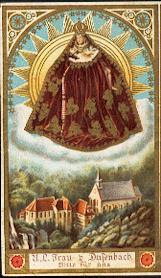
Wednesday, February 28, 2007
A Question
I've been trying to figure out how the decoration on the vaulting and columns at Good Shepherd, in East Toledo could possibly be so beautifully preserved with minimal maintenance over the years. Just doesn't seem possible. Could it be glazed terra-cotta? There's a lot of that in Toledo. Oh, my, it would have been expensive, though. Still, it would explain a lot. Anyone out there know?
Good Shepherd, East Toledo
 Oh, dear. It's hard to know where to begin with this one. There's far too much for one post, that's for sure. Let's start with the exterior. Good Shepherd is one of the old Irish parishes and the building was started in 1899 and consecrated in 1901. It, along with St. Patrick's, is one of the city's most noticable churches. The views from the High Level Bridge and from Downtown make it impossible for it not to be noticed. The first time I went down Summit Street I spotted that dome. Guess what, it's even better at close range. Though a bit grimy from air pollution, the walls are made of an almost honey-colored stone, mixed with white. A thorough cleaning and it would bowl you over. Even with the darkening, it's impressive. The stone blends well with the patina on the metal. Look at those towers. Of all the towers in Toledo, I think they're my favorites. Those soaring open arches are hard not to love. The wider, squared lower parts, with their corner finials, really set them off. Now, look at the entrance. It's an arcade with Romanesque, almost Celtic carving on the capitals. Over it is a nice gallery. Hard to believe it survived. They're often pulled down "for ease of maintenance". ( Read: "general laziness" ) Up in the gable is a niche containing a bronze statue of the Good Shepherd. Its base extends as a semicircle out from the wall and is covered with a riot of carving. On it, the Celtic sort of carving is particularly noticable ( Click HERE for a picture ) Remember, there was a lot of Romanesque carving at the time, but the Celtic influence was rather rare. Overall, the design of this building is quite good, though the transepts don't quite live up to the rest. They're a bit bland.
Oh, dear. It's hard to know where to begin with this one. There's far too much for one post, that's for sure. Let's start with the exterior. Good Shepherd is one of the old Irish parishes and the building was started in 1899 and consecrated in 1901. It, along with St. Patrick's, is one of the city's most noticable churches. The views from the High Level Bridge and from Downtown make it impossible for it not to be noticed. The first time I went down Summit Street I spotted that dome. Guess what, it's even better at close range. Though a bit grimy from air pollution, the walls are made of an almost honey-colored stone, mixed with white. A thorough cleaning and it would bowl you over. Even with the darkening, it's impressive. The stone blends well with the patina on the metal. Look at those towers. Of all the towers in Toledo, I think they're my favorites. Those soaring open arches are hard not to love. The wider, squared lower parts, with their corner finials, really set them off. Now, look at the entrance. It's an arcade with Romanesque, almost Celtic carving on the capitals. Over it is a nice gallery. Hard to believe it survived. They're often pulled down "for ease of maintenance". ( Read: "general laziness" ) Up in the gable is a niche containing a bronze statue of the Good Shepherd. Its base extends as a semicircle out from the wall and is covered with a riot of carving. On it, the Celtic sort of carving is particularly noticable ( Click HERE for a picture ) Remember, there was a lot of Romanesque carving at the time, but the Celtic influence was rather rare. Overall, the design of this building is quite good, though the transepts don't quite live up to the rest. They're a bit bland.Tomorrow, I'll start posting on the interior. That's where we really can cut loose. It may well be the best church interior in Northwest Ohio. And I don't say things like that lightly. It's incredible.
Immaculate Conception, Old South End
A Few Words About This Blog
There are several purposes to this particular blog, in addition to the fun of it. One is as part of my research into the architecture of the area's churches. I'm always looking for more information. If you have anything that might be of help, don't hesitate to leave a comment, or e-mail me at rovingmedievalist@yahoo.com
Pictures of churches anywhere in the diocese are particularly welcome.
Another purpose is to make residents of the area aware of what a treasure trove we have. There's an old line about familiarity breeding contempt. To an extent, it's true and needs to be counteracted.
The purpose of this blog is NOT to discuss theology. If you want that, ask your priest or click on the Vatican links in the sidebar. I WILL, however deal with regulations concerning church design and furnishing. A lot of nonsense has been spouted on the subject in the last few decades. Most of the rearrangements due to "Vatican II" had nothing to do with any of the Council's documents and everything to do with the desires of a few heterodox designers and "liturgists". When I see something wrong, I'll mention it. Changing it would be the bishop's problem, not mine. I certainly don't envy the man.
Pictures of churches anywhere in the diocese are particularly welcome.
Another purpose is to make residents of the area aware of what a treasure trove we have. There's an old line about familiarity breeding contempt. To an extent, it's true and needs to be counteracted.
The purpose of this blog is NOT to discuss theology. If you want that, ask your priest or click on the Vatican links in the sidebar. I WILL, however deal with regulations concerning church design and furnishing. A lot of nonsense has been spouted on the subject in the last few decades. Most of the rearrangements due to "Vatican II" had nothing to do with any of the Council's documents and everything to do with the desires of a few heterodox designers and "liturgists". When I see something wrong, I'll mention it. Changing it would be the bishop's problem, not mine. I certainly don't envy the man.
More on St. Thomas Aquinas
 My post on St. Thomas Aquinas Parish mentioned some of the artwork. A commenter was kind enough to send links to the works in question. Above is the tapestry portrait of St. Thomas Aquinas, by John Nava. It's very good work. You'll find more information at the artist's website, HERE. Mr. Nava seems to have done a series of these tapestries for Corpus Christi University Parish. You'll find them HERE. They're beautiful work, but I have to mention a serious problem. The portrayal of individuals, no matter how praiseworthy, who have not been canonized as saints, complete with halo, is highly irregular. There is absolutely no excuse for acts like this. Fortunately, if the matter hasn't already been handled, it's the bishop's problem, not mine. I've found that when things like this happen in university parishes, it's usually not the students, but faculty members who are in need of a good swift kick.
My post on St. Thomas Aquinas Parish mentioned some of the artwork. A commenter was kind enough to send links to the works in question. Above is the tapestry portrait of St. Thomas Aquinas, by John Nava. It's very good work. You'll find more information at the artist's website, HERE. Mr. Nava seems to have done a series of these tapestries for Corpus Christi University Parish. You'll find them HERE. They're beautiful work, but I have to mention a serious problem. The portrayal of individuals, no matter how praiseworthy, who have not been canonized as saints, complete with halo, is highly irregular. There is absolutely no excuse for acts like this. Fortunately, if the matter hasn't already been handled, it's the bishop's problem, not mine. I've found that when things like this happen in university parishes, it's usually not the students, but faculty members who are in need of a good swift kick.I also mentioned the Stations of the Cross, colorful prints by an artist called Sieger Koder. They serve their purpose and add a lot to the atmosphere. You'll find a set of them HERE.
Tuesday, February 27, 2007
Announcement
Light posting today. I'll make up for it tomorrow. That's when I'll handle Good Shepherd. I'll have a lot to say on that one.
Immaculate Conception, Old South End
Monday, February 26, 2007
Late Breaking News!
Congratulations to St. Stephen's parish, in East Toledo on their new website. It's a good one! I'll be posting on St. Stephen's this week, as a result of my East Toledo tour. To have a look at the wonderful work they've done for their introduction to cyberspace, click HERE.
Toledo Symphony
There'll be a concert by the Toledo Symphony at my parish, Immaculate Conception, in the Old South End, on Friday, March 16. The program will start at 7:30 PM. It's part of the Huntingdon Bank Neighborhood Concert Series. Tickets will be available at the door and will cost $10, half price for children 12 and under. Chelsea Tipton II will conduct, but will be joined by a guest conductor, none other than Father Paul Kwiatkowski. One other thing. A reception will follow. I've never seen receptions done quite so well as they're done at Immaculate Conception. Plan on sticking around.
Plenty on the Way
My trip to East Toledo on Saturday turned into a whirlwind tour and I have a lot to say as the week progresses. In particular, I'll be saying a lot about Good Shepherd. I'll start as soon as the sensory overload lessens and I think of enough superlatives to describe one of the most beautiful parish church interiors I've ever seen.
St. Thomas Aquinas, East Toledo
 The period from 1945 to about five years from now has produced a lot of disgustingly ugly churches. This is NOT one of them. The style really isn't in line with my taste, but it's really not bad at all. The brick is a rich, warm color, as is the stone on the front wall. The clerestory, with its windows and decorative buttresses, is really one of the nicest touches I've seen on something of this period. I can't even find anything wrong with the tower, though these square ones are usually awful. This one is just interesting enough to work. I think it's the cross shape of it that does the job. The only problem is that big expanse of blank stone in the front. A good statue would do wonders and make this, quite possibly, the best product of its style in Toledo.
The period from 1945 to about five years from now has produced a lot of disgustingly ugly churches. This is NOT one of them. The style really isn't in line with my taste, but it's really not bad at all. The brick is a rich, warm color, as is the stone on the front wall. The clerestory, with its windows and decorative buttresses, is really one of the nicest touches I've seen on something of this period. I can't even find anything wrong with the tower, though these square ones are usually awful. This one is just interesting enough to work. I think it's the cross shape of it that does the job. The only problem is that big expanse of blank stone in the front. A good statue would do wonders and make this, quite possibly, the best product of its style in Toledo. Inside, the clerestory and the nice, warm tone of the brick make the place light and airy. The beamed cieling is superb. The parquetry effect of the wood paneling on the wall behind the altar avoids the barrenness of a blank wall. The crucifix is excellent. There's one other feature that really stands out. The altar is beautiful. It's made of a dark pinkish stone that really adds the right note of color. Unfortunately, the tabernacle has been moved into what amounts to a stairwell and the two statues have been put together on the left side. Two touches that are not visible in this picture are worth mentioning. There's a wonderful large banner ( No, it's not felt. If it was, I wouldn't be mentioning it ) with a portrait of St. Thomas. It's a heavy sort of material and was made by the artist responsible for the similar banners that are almost the only good feature of that mausoleum of a cathedral Los Angeles has recently been saddled with. I'll have to get a picture of it someday. The other is a set of Stations of the Cross. They're very colorful prints. As works of art, they're nothing to crow about, but they're colorful and they serve their purpose. Overall, if you have to have a late 20th century parish church, this is the way to go.
Inside, the clerestory and the nice, warm tone of the brick make the place light and airy. The beamed cieling is superb. The parquetry effect of the wood paneling on the wall behind the altar avoids the barrenness of a blank wall. The crucifix is excellent. There's one other feature that really stands out. The altar is beautiful. It's made of a dark pinkish stone that really adds the right note of color. Unfortunately, the tabernacle has been moved into what amounts to a stairwell and the two statues have been put together on the left side. Two touches that are not visible in this picture are worth mentioning. There's a wonderful large banner ( No, it's not felt. If it was, I wouldn't be mentioning it ) with a portrait of St. Thomas. It's a heavy sort of material and was made by the artist responsible for the similar banners that are almost the only good feature of that mausoleum of a cathedral Los Angeles has recently been saddled with. I'll have to get a picture of it someday. The other is a set of Stations of the Cross. They're very colorful prints. As works of art, they're nothing to crow about, but they're colorful and they serve their purpose. Overall, if you have to have a late 20th century parish church, this is the way to go.Stay Tuned
Cardinal Schoenborn on ad orientem and versus populum
You'll find a lengthy quote at The Cafeteria is Closed. Among many good points, he says that we should recognize the value of BOTH, without politicizing the issue, and dispels a few myths. Well worth reading.
Empty Fonts Are Not Permissable
I don't know if any local parishes have tried the practice of removing the holy water from fonts during all of Lent. If they have, you might want to tell them that this practice is not approved by the Vatican. Just read the letter quoted below. Hat tip to Orthometer.
"Prot. N. 569/00/L
March 14, 2000
Dear Father:
This Congregation for Divine Worship has received your letter sent by fax in which you ask whether it is in accord with liturgical law to remove the Holy Water from the fonts for the duration of the season of Lent.
This Dicastery is able to respond that the removing of Holy Water from the fonts during the season of Lent is not permitted, in particular, for two reasons:
1. The liturgical legislation in force does not foresee this innovation, which in addition to being praeter legem is contrary to a balanced understanding of the season of Lent, which though truly being a season of penance, is also a season rich in the symbolism of water and baptism, constantly evoked in liturgical texts.
2. The encouragement of the Church that the faithful avail themselves frequently of the [sic] of her sacraments and sacramentals is to be understood to apply also to the season of Lent. The "fast" and "abstinence" which the faithful embrace in this season does not extend to abstaining from the sacraments or sacramentals of the Church. The practice of the Church has been to empty the Holy Water fonts on the days of the Sacred Triduum in preparation of the blessing of the water at the Easter Vigil, and it corresponds to those days on which the Eucharist is not celebrated (i.e., Good Friday and Holy Saturday).
Hoping that this resolves the question and with every good wish and kind regard, I am,
Sincerely yours in Christ,
[signed]Mons. Mario Marini
Undersecretary"
"Prot. N. 569/00/L
March 14, 2000
Dear Father:
This Congregation for Divine Worship has received your letter sent by fax in which you ask whether it is in accord with liturgical law to remove the Holy Water from the fonts for the duration of the season of Lent.
This Dicastery is able to respond that the removing of Holy Water from the fonts during the season of Lent is not permitted, in particular, for two reasons:
1. The liturgical legislation in force does not foresee this innovation, which in addition to being praeter legem is contrary to a balanced understanding of the season of Lent, which though truly being a season of penance, is also a season rich in the symbolism of water and baptism, constantly evoked in liturgical texts.
2. The encouragement of the Church that the faithful avail themselves frequently of the [sic] of her sacraments and sacramentals is to be understood to apply also to the season of Lent. The "fast" and "abstinence" which the faithful embrace in this season does not extend to abstaining from the sacraments or sacramentals of the Church. The practice of the Church has been to empty the Holy Water fonts on the days of the Sacred Triduum in preparation of the blessing of the water at the Easter Vigil, and it corresponds to those days on which the Eucharist is not celebrated (i.e., Good Friday and Holy Saturday).
Hoping that this resolves the question and with every good wish and kind regard, I am,
Sincerely yours in Christ,
[signed]Mons. Mario Marini
Undersecretary"
Sunday, February 25, 2007
Another Line of BS on the Way
You'll probably be hearing about the discovery of the tomb of Our Lord from a pseudo-scholarly documentary in the near future. I just posted on it at The Roving Medievalist. You might find it interesting.
Saturday, February 24, 2007
Sensory Overload
My visit to East Toledo, this morning, turned into a whirlwind tour of every Catholic church over there. I'll be posting for a week about the results.
St. John, Lima
Day Off
I'm heading over to East Toledo this morning to get a good look at Good Shepherd. With one thing or another, I'll be occupied most of the day. I'll try to post early tomorrow morning.
Friday, February 23, 2007
St. Joseph, Fort Jennings
Old St. Caspar's, Wauseon
 Very nice. I wonder if that was a window behind the crucifix? The vaulting over it is rather unusual. I like that Sacred Heart statue to the left of the altar.
Very nice. I wonder if that was a window behind the crucifix? The vaulting over it is rather unusual. I like that Sacred Heart statue to the left of the altar.There was a time when most churches had stencilling like this. It was a common decorative element for the sanctuary. A lot of it was lost in the elitist period of the 60's and 70's. The general attitude of "liturgists" was that you and I, the laity, were hopeless idiots who had to be kept in line. They felt that we would be distracted by things like this. Sort of the same sort of thing as the attitude that we're too stupid to understand a correct translation from the Latin. In their general lack of common sense, they failed to realize that a blank wall would be more distracting and might actually cause drowsyness. Another example is the jacuzzi sort of baptismal font. The sound of running water was supposed to be relaxing. Well, it may be, under the right circumstances, but it can also be deucedly distracting. And we won't mention how problematic it can be for people with kidney problems. As with most things, it would have been better to think before acting. Unfortunately, for people of that period, thinking was not a priority. Rushing headlong into a future that never even remotely met their grandiose expectations was more the fashion.
Thursday, February 22, 2007
Old St. Mary, Shelby
Wednesday, February 21, 2007
Old St. Mary's, Shelby
 Most Pure Heart of Mary, to be exact. Very unusual. I've never seen a ceiling quite like that. The high, narrow sanctuary is different. Notice how high those statues are placed flanking the altar. I don't quite know what to say about the chandelier. The Stations of the Cross look like they're wonderful work. I wonder what became of them. There'll be more on this parish, both this building and the one that replaced it in the 1920's as the week goes by.
Most Pure Heart of Mary, to be exact. Very unusual. I've never seen a ceiling quite like that. The high, narrow sanctuary is different. Notice how high those statues are placed flanking the altar. I don't quite know what to say about the chandelier. The Stations of the Cross look like they're wonderful work. I wonder what became of them. There'll be more on this parish, both this building and the one that replaced it in the 1920's as the week goes by.Tuesday, February 20, 2007
St. John, Glandorf
 Magnificent! What a tower! Look at that corbelling at the top. The gables on the tower are a wonderful idea. I'll have to try to get down there someday to see what that decoration is near the top of the spire. Notice the little window at the peak of the tower gable. The brick at the entrances looks as if they might have been added later, but they certainly work. I'd like to get a closer look at the one in the center. Looks like the arch might be alternating brick and stone. Those windows above them may be the best feature of all. Notice the gabled hoods over them. Overall, this one's a gem. There's a link to their website in the sidebar.
Magnificent! What a tower! Look at that corbelling at the top. The gables on the tower are a wonderful idea. I'll have to try to get down there someday to see what that decoration is near the top of the spire. Notice the little window at the peak of the tower gable. The brick at the entrances looks as if they might have been added later, but they certainly work. I'd like to get a closer look at the one in the center. Looks like the arch might be alternating brick and stone. Those windows above them may be the best feature of all. Notice the gabled hoods over them. Overall, this one's a gem. There's a link to their website in the sidebar.St. Peter
 An encaustic painting from the 6th ( yes, that's 6th ) century, at St. Catherine's Monastery on Mt. Sinai. The portrayals of St. Peter as looking like this, and of St. Paul as rather thin, bald, and with a longer, slightly pointed beard, were already at least a few hundred years old when this was made. It just about has to be the result of earlier paintings made from life or recent memory.
An encaustic painting from the 6th ( yes, that's 6th ) century, at St. Catherine's Monastery on Mt. Sinai. The portrayals of St. Peter as looking like this, and of St. Paul as rather thin, bald, and with a longer, slightly pointed beard, were already at least a few hundred years old when this was made. It just about has to be the result of earlier paintings made from life or recent memory.Complaints Work...Sometimes
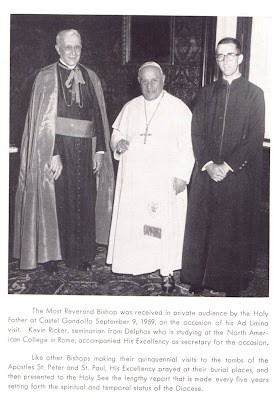 I made a remark about how hard it is to track down pictures of Toledo's bishops and, almost immediately, got an e-mail from Kevin Hammer with two of them. The one above is Bishop Rehring with Bl. John XXIII. It was taken at Castel Gandolfo during an ad limina visit on September 9, 1959. The young man at the left is Kevin Ricker, a seminarian from Delphos. He was studying at the North American College in Rome. Anyone know what became of him? Considering the disastrous results of the "spirit of Vatican II", though not of the Council itself, it's anybody's guess.
I made a remark about how hard it is to track down pictures of Toledo's bishops and, almost immediately, got an e-mail from Kevin Hammer with two of them. The one above is Bishop Rehring with Bl. John XXIII. It was taken at Castel Gandolfo during an ad limina visit on September 9, 1959. The young man at the left is Kevin Ricker, a seminarian from Delphos. He was studying at the North American College in Rome. Anyone know what became of him? Considering the disastrous results of the "spirit of Vatican II", though not of the Council itself, it's anybody's guess.Monday, February 19, 2007
Subscribe to:
Posts (Atom)











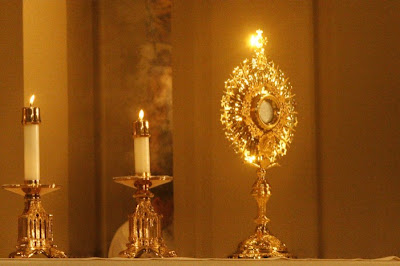





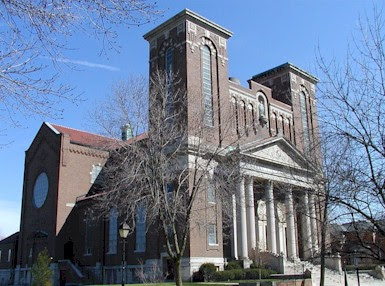
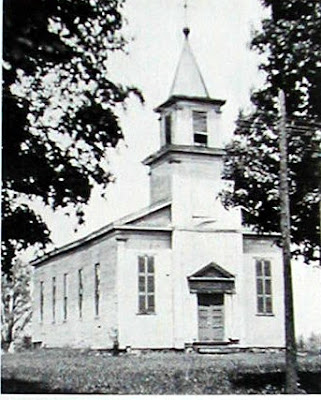
















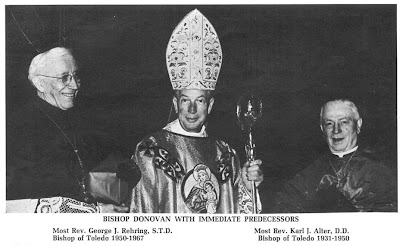


.png)







.png)








